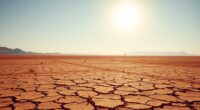La Niña 2025–26, driven by shifts in the Pacific Oscillation, is likely to create diverse soaring conditions worldwide. Expect wetter skies and increased storms in regions like Australia and Southeast Asia, which could boost lift and flight opportunities. Conversely, areas like the southwestern U.S. and parts of South America may face droughts, reducing soaring conditions. Staying informed about these climate patterns helps you anticipate changes in your flying environment—there’s much more to uncover as these impacts unfold.
Key Takeaways
- La Niña 2025–26, driven by a negative Pacific Oscillation, is expected to influence global weather patterns significantly.
- Enhanced atmospheric stability during La Niña may lead to improved soaring conditions in some regions.
- Regions like Australia and Southeast Asia might experience increased rainfall, affecting visibility and wind conditions for soaring.
- Drought-prone areas such as the southwestern U.S. could see clearer skies and more consistent winds, favoring soaring activities.
- Monitoring Pacific Oscillation trends helps forecast regional weather impacts, aiding pilots and enthusiasts in planning safe soaring flights.

As the climate patterns shift, understanding La Niña 2025–26 becomes essential for preparing for its potential impacts. During this period, you’ll notice the influence of the Pacific Oscillation, a key player in shaping global climate variability. The Pacific Oscillation refers to the fluctuations in sea surface temperatures in the Pacific Ocean, which directly affect weather patterns worldwide. When the Pacific Oscillation tilts toward a negative phase, it often correlates with La Niña events, leading to cooler-than-normal ocean temperatures across the central and eastern Pacific. These shifts disrupt typical weather systems, resulting in significant changes to precipitation, temperature, and atmospheric circulation that you’ll need to monitor closely. Understanding the climate variability associated with these oscillations can help you better anticipate regional weather patterns and prepare accordingly.
In the context of global climate, La Niña 2025–26 is expected to drive notable impacts across continents. For instance, regions like Australia and Southeast Asia could face increased rainfall, heightening the risk of flooding and landslides. Conversely, parts of the southwestern United States and South America might experience drought conditions, affecting agriculture and water supplies. The interconnected nature of the global climate means that these regional impacts are part of a larger pattern influenced by the Pacific Oscillation. As sea surface temperatures fluctuate, they alter jet streams and atmospheric circulation, which in turn influences weather far beyond the Pacific Ocean.
Understanding how La Niña interacts with the Pacific Oscillation allows you to better anticipate the severity and distribution of these impacts. When the Pacific Oscillation moves into a negative phase, it typically enhances La Niña conditions, amplifying the likelihood of extreme weather events. This knowledge can help you prepare for potential disruptions, whether it’s adjusting farming practices, planning for emergency responses, or managing water resources. Recognizing the link between the Pacific Oscillation and La Niña also emphasizes the importance of global climate monitoring systems, which track sea surface temperatures and atmospheric patterns in real-time, giving you timely insights into evolving conditions.
Frequently Asked Questions
How Will La Niña Affect Global Agricultural Productivity in 2025–26?
La Niña in 2025–26 will likely boost crop yields in some regions, but also cause droughts and flooding that hurt others. You might see increased pest outbreaks due to stressed plants and changing weather patterns. These fluctuations make it hard for farmers to plan, risking overall productivity. Stay alert to regional forecasts, as La Niña’s effects will vary widely, impacting your agricultural strategies and harvest outcomes.
What Regions Are Most Likely to Experience Droughts During This La Niña?
Imagine dry, cracked earth whispering of regional droughts and water scarcity. During this La Niña, you’ll find the Southwest US, parts of Australia, and southern Africa most at risk. These areas face prolonged dry spells, like a parched river struggling for life. Prepare for decreased water availability and stressed ecosystems as these regions grapple with the harsh reality of droughts, impacting agriculture, livelihoods, and daily life.
How Accurate Are La Niña Forecasts for Such Long-Term Periods?
Climate prediction for La Niña over long-term periods has moderate forecast reliability, but it’s not perfect. You should know that while scientists improve models continuously, uncertainties remain, especially for multi-year forecasts. You can generally trust short-term predictions more than those spanning several seasons or years. So, for accurate planning, consider these forecasts as helpful guides but stay updated on new data and revisions for better precision.
What Mitigation Strategies Can Communities Adopt for La Niña Impacts?
Imagine turning challenges into opportunities—your community can do just that by boosting engagement and fortifying infrastructure. You should promote community engagement initiatives to raise awareness and foster collective action. Strengthening infrastructure resilience, like upgrading drainage systems and water management, minimizes damage from La Niña’s impacts. These proactive strategies help you adapt effectively, ensuring safety and sustainability despite unpredictable weather patterns. Your proactive steps make all the difference.
How Does La Niña Influence Oceanic Ecosystems Beyond Weather Patterns?
La Niña influences oceanic ecosystems by causing coral bleaching due to cooler surface temperatures and increased nutrient upwelling. You’ll notice fish migration patterns shift as species move to find suitable habitats, often disrupting local fisheries. These changes impact biodiversity and food chains, making ecosystems more vulnerable. By understanding these effects, you can better support conservation efforts and adapt your activities to protect marine environments during La Niña events.
Conclusion
As La Niña 2025–26 unfolds, you can’t help but wonder how this shifting climate will reshape your world. Will the relentless droughts deepen, or will sudden storms catch you off guard? The forecast hints at a tense future, where every weather change could hold surprises. Stay alert, because what’s coming next might just redefine your experience of seasons—if you’re prepared for what’s lurking just beyond the horizon.
With a heart that soars as high as the skies, Aria, affectionately known as “Skylark,” is the driving force behind Soaring Skyways. Her journey into the gliding world began as a young dreamer gazing up at the soaring birds, yearning to experience the weightlessness and freedom they embodied. With years of experience both in the cockpit and behind the scenes, Aria’s commitment to the gliding community is unwavering.










